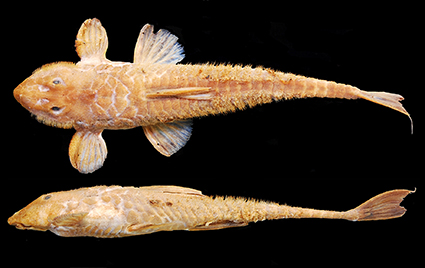Abstract
Although the genus Rineloricaria is widely distributed in the Neotropical region, its species usually occupy single drainages with high habitat fidelity. Rineloricaria species show evident sexual dimorphism with hypertrophied odontodes in sexually mature males. Here, we describe a new species of Rineloricaria present in the Rio Paraiba do Sul basin and coastal rivers in Rio de Janeiro State. The new species has extreme sexual dimorphism making possible to differentiate it from all congeners. The new species can also be separated from other sympatric species by morphometric characteristics and dermal plates pattern.
References
Abell, R., Thieme, M.L., Revenga, C., Bryer, M., Kottelat, M., Bogutskaya, N., Coad, B., Mandrak, N., Balderas, S.C., Bussing, W., Stiassny, M.L.J., Skelton, P., Allen, G.R., Unmack, P., Naseka, A., Ng, R., Sindorf, N., Robertson, J., Armijo, E., Higgins, J. V, Heibel, T.J., Wikramanayake, E., Olson, D., López, H.L., Reis, R.E., Lundberg, J.G., Sabaj Pérez, M.H., Petry, P., Pérez, M.H.S., Petry, P. & Abell, R., Thieme, M.L., Revenga, C., Bryer, M., Kottelat, M., Bogutskaya, N., Coad, B., Mandrak, N., Balderas, S.C., Bussing, W., Stiassny, M.L.J., Skelton, P., Allen, G.R., Unmack, P., Naseka, A., Ng, R., Sindorf, N., Robertson, J., Armijo, E., Higgins, P. (2008) Freshwater Ecoregions of the World: A New Map of Biogeo- graphic Units for Freshwater Biodiversity Conservation. BioScience, 58, 403. https://doi.org/10.1641/B580507
Albert, J.S., Petry, P. & Reis, R.E. (2011) Major Biogeographic and Phylogenetic Patterns. In: Albert, J.S. & Reis, R.E. (Eds.), Historical Biogeography of Freshwater Fishes. University of California Press, Berkeley, Los Angeles, London, pp. 21–58.
Bizerril, C. (1998) A Ictiofauna da Bacia do Rio Paraíba do Sul. Biodiversidade e Padrões Biogeográficos. Brazilian Archives of Biology and Technology, 41, 67–81.
Costa-Silva, G.J., Rodriguez, M.S., Roxo, F.F., Foresti, F. & Oliveira, C. (2015) Using different methods to access the difficult task of delimiting species in a complex neotropical hyperdiverse group. PLoS ONE, 10, 1–12. https://doi.org/10.1371/journal.pone.0135075
Covain, R. & Fisch-Muller, S. (2007) The genera of the Noetropical armored catfish Loricariinae (Silurformes: Loricariidae): a practical key and synopsis. Zootaxa 1462, 1–40. https://doi.org/10.11646/zootaxa.1462.1.1
Covain, R., Fisch-Muller, S., Montoya-Burgos, J.I., Mol, J.H., Bail, P.Y.L.E. & Dray, S. (2012) The harttiini (siluriformes, loricariidae) from the Guianas: A multi-table approach to assess their diversity, evolution, and distribution. Cybium 36, 115–161. https://doi.org/10.26028/cybium/2012-361-010
Fricke, R., Eschmeyer, W.N. & Van der Laan, R. (2021) Eschmeyer’s catalog of fishes: Genera, species, references. Electronic version. Available from: https://www.calacademy.org/scientists/projects/eschmeyers-catalog-of-fishes (accessed 11 June 2021)
Ghazzi, M.S. (2008) Nove espécies novas do gênero Rineloricaria (Siluriformes, Loricariidae) do rio Uruguai, do sul do Brasil. Iheringia, Série Zoologia, 98, 100–122. https://doi.org/10.1590/S0073-47212008000100014
Henriques, J.M., Silva, G.J.C., Ashikaga, F.Y., Hanner, R., Foresti, F. & Oliveira, C. (2015) Use of DNA barcode in the identification of fish species from Ribeira de Iguape Basin and coastal rivers from São Paulo State (Brazil). DNA Barcodes, 3 (1), 118–128.
Isbrucker, I.J.H. (1979) Descriptions preliminaires de nouveaux taxa de la famille des Loricariidae, Poisson-Chats cuirassés néotropicaux avec un catalogue de la sous-famillie nominale (pisces, Siluriformes). Revue Française d’Aquariologie et Herpétologie, 5, 86–116.
Langeani, F. & Araujo, R.B. (1994) O gênero Rineloricaria Bleeker, 1862 (Ostariophysi, Siluriformes) na bacia do rio Paraná Superior: Rineloricaria pentamaculata sp. n. e Rineloricaria latirostris (Boulenger, 1900). Comunicação do Museu de Ciências e Tecnologia PUCRS, Série Zoologia, 7, 151–166.
Londoño-Burbano, A. & Urbano-Bonilla, A. (2018) A new species of Rineloricaria (Teleostei: Loricariidae) from the upper Vaupés River, Amazon River basin, Colombia. Ichthyological Exploration of Freshwaters, 22, 185–192.
https://doi.org/10.1134/S0032945209100051
Oyakawa, O.T. (1993) Cinco espécies novas de Hartia Steindachner, 1876 da região sudeste do Brasil, e comnetários sobre o gênero (Teleostei, Siluriformes, Loricariidae). Comunicação do Museu de Ciências e Tecnologia PUCRS, Série Zoologia, 6, 3–27.
Rivera-Rivera, C.J. & Montoya-Burgos, J.I. (2017) Trunk dental tissue evolved independently from underlying dermal bony plates but is associated with surface bones in living odontode-bearing catfish. Proceedings of the Royal Society B: Biological Sciences, 284 (1865). [published online] https://doi.org/10.1098/rspb.2017.1831
Rodrigues, R.M. (2010) Estudos cromossômicos e moleculares em Loricariinae com ênfase em espécies de Rineloricaria (Siluriformes, Loricariidae): uma perspectiva evolutiva. PhD Thesis, 218 pp. Available from: https://www.teses.usp.br/teses/disponiveis/41/41131/tde-17122010-104716/publico/Raque_Maria_Rodrigues.pdf (accessed 1 August 2022)
Rodriguez, M.S. & Reis, R.E. (2008) Taxonomic Review of Rineloricaria (Loricariidae: Loricariinae) from the Laguna dos Patos Drainage, Southern Brazil, with the Descriptions of Two New Species and the Recognition of Two Species Groups. Copeia, 2008, 333–349. https://doi.org/10.1643/CI-06-218
Schaefer, S.A. (1997) The Neotropical cascudinhos: Systematic and biogeography of the Otocinclus catfishes (Siluriformes: Loricariidae). Proceedings of the Academy of Natural Sciences of Philadelphia, 148, 1–120.
Vera-Alcaraz, H.S., Pavanelli, C.S. & Zawadzki, C.H. (2012) Taxonomic revision of the Rineloricaria species (Siluriformes: Loricariidae) from the Paraguay River basin. Neotropical Ichthyology 10, 285–311. https://doi.org/10.1590/S1679-62252012000200006


